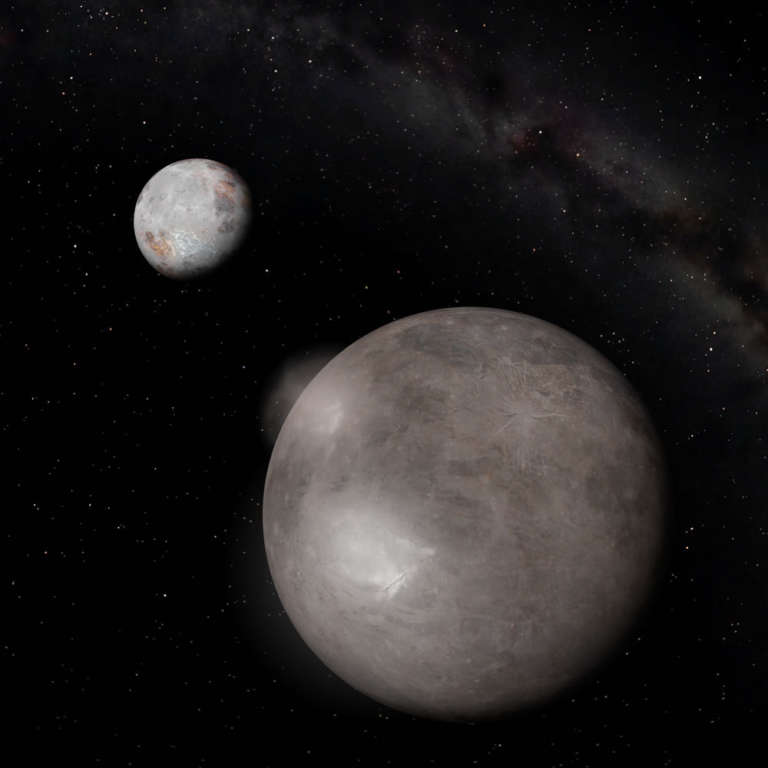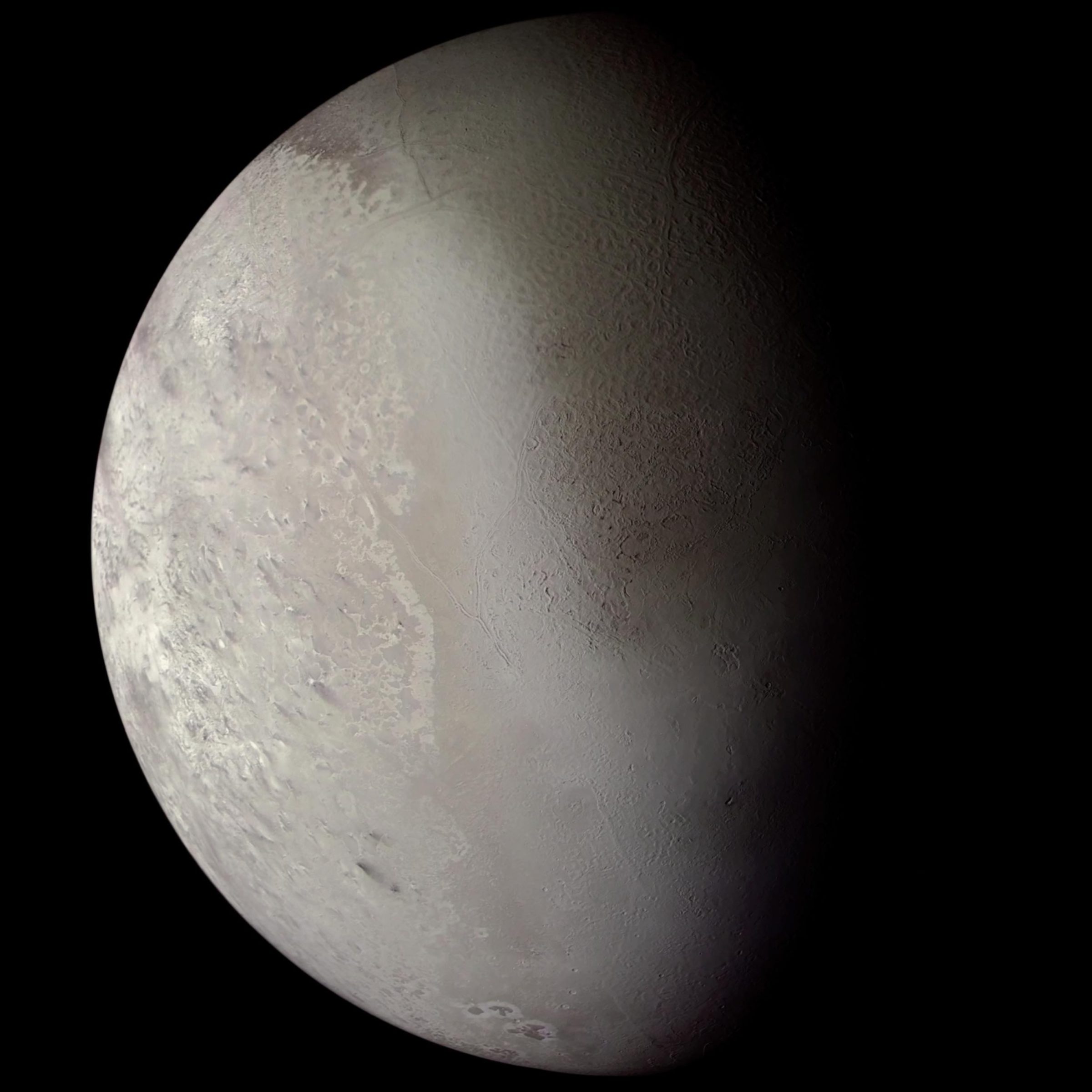Emily Lakdawalla • Jul 18, 2007
Yet another active world: Charon
Pluto's companion Charon might be covered with active volcanoes of ammonia-rich water spewing forth from the moon's deep interior. Astronomers at one of the world's great telescopes have separated Charon's dim light from Pluto's and discovered that large areas of the moon's surface are plastered with deposits of crystalline water and ammonia hydrate ice. Such crystalline materials can't last long on an airless world before cosmic rays age and destroy their ordered structure, so they must be replenished regularly. "Some mechanism is renewing Charon's surface, and cryovolcanism is the most probable of the possible mechanisms," write Jason Cook, Steven Desch, Ted Roush, Chad Trujillo, and Tom Geballe in a paper they published this week in The Astrophysical Journal.

"The detection of crystalline water ice and ammonia hydrates on intermediate-sized Kuiper belt objects [including Charon] demands explanation," Cook and coauthors write. The problem is that crystalline ice -- so typical of cold climates here on Earth -- actually needs unusually warm environments to form in the frigid reaches of the outer solar system. It requires temperatures above 78 Kelvin (-195 Celsius, -319 Fahrenheit) to form, whereas the surface of Charon is only around 40-50 Kelvin (about -230 Celsius or -390 Fahrenheit). All of these temperatures may seem cold to us humans, but consider how much warmer a 35-Celsius (95-Fahrenheit) day is than a 0-Celsius (32-Fahrenheit) day and you'll understand how much warming Charon ice must experience to crystallize.
"In addition to the mystery of how crystalline ice is created, there is the question of how it survives," Cook and coauthors say. "Exposure to radiation tends to destroy the bonds that keep the water molecules in an ordered structure, and at the temperatures that persist beyond about 15 Astronomical Units, the ice cannot reassemble itself into crystalline form. The ice should therefore be amorphous." Since it is evidently not amorphous -- less than 10% of the surface seems to be covered with amorphous ice -- crystalline ice must be resupplied to Charon's surface somehow.
There are three main ways that Charon's surface supply of crystalline ice could have been replenished. First, the solid ice on the surface could have been annealed, meaning that its temperature could have been raised above the 78 Kelvin mark to allow the amorphous ice to recrystallize. Second, there could have been some process such as convection or impact gardening that brought ice from depth (where it would be warmer and therefore crystalline) up to the surface. Third, most exciting, and, it turns out, most plausible, is the possibility that liquid water from Charon's interior has erupted onto the surface, freezing and crystallizing. Whichever one of these processes is renewing Charon's surface, it must be happening now or have happened in the last few tens of thousands of years.
The Most Probable of the Possible Mechanisms
The cryovolcanism scenario goes like this. It is possible that Charon may currently have an internal ocean, a layer of ammonia-water about 15 kilometers (10 miles) thick between its rocky core and icy mantle (more on how this is possible below). When water from that ocean freezes into ice, a process that must continually move forward as Charon cools, the ice occupies more volume than the water it formed from. The ocean must expand, but it is confined beneath Charon's stiff, icy shell, so the pressure rises. Under these conditions, any crack that begins to form in the ice shell propagates quickly -- within one hour! -- to Charon's surface. Water gushes from Charon's deep interior, spewing forth in icy volcanoes, the "lava" freezing instantly into tiny ice crystals and snowing down to the moon's surface.
Charon's "magma" -- the deep fluids that power its volcanoes -- would be a water-ammonia liquid, made of two-thirds water and one-third ammonia. As this fluid gushes to the surface, some of the water would freeze against the crack walls, much as Earth lava pours forth from volcanoes while simultaneously freezing to the walls of its conduits. Under these circumstances, what comes out of a vent can have different compositions depending on the particular conditions of the eruption. Indeed, Cook and coauthors found evidence that Charon's surface composition differs between its Pluto-facing and anti-Pluto faces, with the sub-Pluto face showing deposits of more ammonia-rich ammonia hemihydrate (NH3 · 0.5H2O) and the anti-Pluto face more water-rich ammonia dihydrate (NH3 · 2H2O).
What's the evidence?
The detection of crystalline water ice and various ammonia hydrates was made with the 8-meter Gemini telescope on Mauna Kea. Gemini is equipped with adaptive optics to reduce the blurring effect of Earth's atmosphere on the dim light from Pluto and Charon. The team's measurements did not resolve surface features on Charon -- their conclusions are based upon light levels measured across Charon's entire visible disk. They didn't need the sharp vision of Gemini to resolve Charon's features; rather, they needed it to keep light from Pluto from bleeding in to their measurements of Charon. Pluto, being nearly an order of magnitude brighter than Charon and having a much different surface composition dominated by methane, would utterly swamp the measurements if its light could not be separated from Charon's.
Having separated Charon's light from Pluto's, the team was able to split Charon's light into 600 slivers along the infrared spectrum and determine how Charon reflects light at different wavelengths. They found that Charon's spectrum contained several dips or "absorption features" that are like fingerprints for the materials that make up Charon's surface. Many of these absorption features are due to the presence of water in different forms: dips at wavelengths of 1.5 and 2.0 micrometers indicate amorphous water ice, but a dip observed in Charon's spectrum at 1.65 micrometers clearly indicates that crystalline water ice is present. In addition, a curious feature at 2.21 micrometers is likely an indicator of ammonia hydrate, an ice composed of ammonia intimately mixed with water. Like water ice, ammonia hydrates are also modified by cosmic rays, such that its detection on Charon's surface argues for surface change within the last 20 million years or so.

Cook and his coauthors examined each of the ways that they suggested Charon's surface could be renewed and found all but the cryovolcanic model to be lacking. For example, it's possible that impacts from micrometeorites on up to comets could "garden" Charon's surface, bringing crystalline ice up from depth. But their calculations show that "While impacts can uncover fresh crystalline ice, no more than a miniscule fraction of the surface can be covered by fresh ice before it is amorphized." Impacts may also heat the surface, annealing the amorphous ice to crystalline form, but, again, the physics doesn't work; there aren't enough impactors that can deliver enough energy to create enough heat. Finally, the vapor kicked up by impacts could, when refreezing onto the surface, make crystalline ice; but calculations show that "no more than 0.5% of Charon's surface could be crystalline ice recently deposited as frost from vapor created by micrometeorite impacts." Impacts, then, cannot be responsible for Charon's renewed surface. Charon isn't being renewed from the outside; there must be something happening from the inside.
Another cold world with geyser activity is Neptune's moon Triton. Scientists have demonstrated in the past that Triton's geysers can be driven by a "solid-state greenhouse," in which sunlight, both visible and infrared, penetrates several meters deep into the moon's regolith, but then the infrared light is trapped, causing the ice a few meters down to heat and sublimate. Again, though, the math doesn't work for Charon: with a solid-state greenhouse, "the temperature at depth…increases by 5-20 K [5-20 C or 10-35 F], as long as the regolith extends to at least several meters." This just isn't enough: "Even in this optimal case…the temperature under Charon's surface does not rise above 70 K. This is not sufficient to either anneal ice on
Cryovolcanism requires an internal ocean. How is it possible that a world as cold and small as Charon could have an internal ocean? Being so tiny and so small, you might expect Charon to be solidly frozen all the way from its icy surface to its rocky core. But, thanks to the decay of radioactive elements, at one point in its evolution the interior ice would have been molten. Cook and his coauthors show in their paper that if Charon condensed enough ammonia when it first formed (their model requires that at least 15% of Charon's icy mantle was ammonia, a number that is plausible based on models of the formation of the solar system and the abundances predicted for Titan), then there should still be a liquid ocean at great depth, separating the rocky core from the icy mantle.
Based on the rate at which Charon is presently cooling, and its ocean freezng, its volcanoes should be sending forth enough icy lava to cover its surface to a depth of two kilometers (1.2 miles) every billion years, or two millimeters every thousand years. This rate is much faster than the rate at which cosmic rays can amorphize the ice. Cryovolcanism thus stands alone as the only plausible mechanism that Cook and his coauthors came up with that can create crystalline ice faster than cosmic rays can destroy it.
Water, Water Everywhere
This paper doesn't provide conclusive evidence for a volcanic Charon, though it is suggestive. Proof (or disproof) will come from the images and data to be collected by New Horizons during its flyby of the Pluto system in 2015. If New Horizons does show Charon to be volcanically active, the implications for the outer solar system are staggering. There are a few other small worlds in the solar system that are known to be currently or recently active, notably Jupiters moons Io and Europa, and Saturn's moon Enceladus. In these three cases, tidal forces between a giant planet and its moons are invoked to explain the source of energy that drives the geologic activity. But the scenario outlined in Cook's paper doesn't require tidal heating; Charon is quite capable of supplying the necessary energy on its own.
Spectrally speaking, Charon appears typical of medium-sized Kuiper belt objects, of which there are a great many. What's true of Charon may also be true on other worlds such as Orcus, Quaoar, and 2003 EL61. "The possibility is raised," Cook and coauthors write, "that there is more liquid water in the Kuiper belt than on Earth." And that liquid water may be spewing forth from volcanoes on dozens of active worlds in the distant reaches of the solar system.


 Explore Worlds
Explore Worlds Find Life
Find Life Defend Earth
Defend Earth

